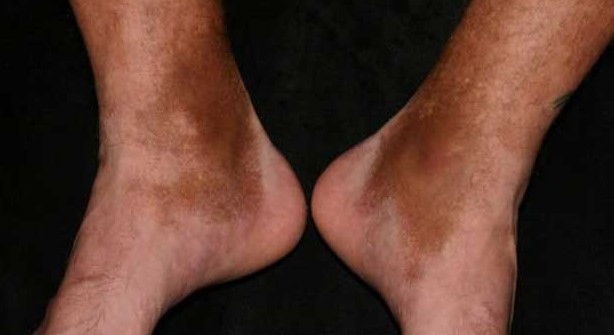The Science behind Hemosiderin Staining: What You Need to Know
Welcome to our blog post on the fascinating topic of hemosiderin staining! If you’ve ever noticed discolored patches on your skin, particularly around your lower legs or ankles, then you may have encountered this condition. Hemosiderin staining occurs when iron particles accumulate in the tissues beneath the skin, causing a characteristic brownish discoloration.
But what causes this intriguing phenomenon? And more importantly, how can it be treated? In this article, we will delve into the science behind hemosiderin staining and explore its various causes and treatment options. Whether you’re curious about chronic venous insufficiency or wondering how varicose vein treatments can lead to hemosiderin staining, we’ve got all the answers for you!
So grab a cup of tea (or coffee if that’s your preference!) and join us as we unravel the mysteries of hemosiderin staining. By understanding its underlying mechanisms and exploring potential remedies, we hope to provide valuable insights for those experiencing this condition. Let’s get started!
What Is Hemosiderin Staining?
Hemosiderin staining, also known as hemosiderosis or iron deposition, refers to the accumulation of iron particles in the tissues beneath the skin. This condition manifests as brownish discoloration, most commonly seen on the legs and ankles. The presence of excess iron causes a breakdown of red blood cells and subsequent leakage of iron into surrounding tissues.
The primary cause of hemosiderin staining is chronic venous insufficiency (CVI), a condition that occurs when veins in the legs fail to efficiently return blood to the heart. In CVI, blood pools in the lower extremities due to weakened vein valves or impaired muscle contractions. Over time, this stagnant blood leads to inflammation and increased permeability of capillaries, resulting in leakage of red blood cells and subsequent deposition of hemosiderin.
Other factors that may contribute to hemosiderin staining include trauma or injury to the affected area, certain medications like oral contraceptives or nonsteroidal anti-inflammatory drugs (NSAIDs), and underlying medical conditions such as hemochromatosis (a genetic disorder causing excessive absorption of dietary iron). Understanding what causes hemosiderin staining is crucial for effective treatment strategies.
What Causes Hemosiderin Staining?
Hemosiderin staining is a common condition that occurs when iron deposits build up in the skin. But what causes this staining to occur in the first place? Let’s take a closer look.
One of the primary culprits behind hemosiderin staining is chronic venous insufficiency (CVI). This condition occurs when the valves in your veins become weak or damaged, causing blood to pool and flow backward. Over time, this stagnant blood can leak into surrounding tissues, leading to the formation of hemosiderin deposits and subsequent discoloration.
Another potential cause of hemosiderin staining is varicose vein treatments. While these procedures are generally safe and effective for treating varicose veins, they can sometimes result in side effects such as bruising or bleeding. If excess blood seeps into the skin during these treatments, it can lead to hemosiderin staining.
Certain medications and medical conditions can also contribute to the development of hemosiderin stains. For example, individuals with kidney disease may have difficulty excreting excess iron from their bodies, leading to its accumulation in various tissues including the skin.
Understanding what causes hemosiderin staining is vital for proper diagnosis and treatment. By identifying underlying factors such as CVI or specific medications, healthcare providers can develop a targeted approach to address both the root cause and visible symptoms of this condition.
Treatment for Hemosiderin Staining
When it comes to treating hemosiderin staining, the approach will depend on its underlying cause. In some cases, addressing the root cause of the condition can help reduce or eliminate hemosiderin staining. For example, if chronic venous insufficiency is causing the staining, treatment options may include compression therapy to improve blood flow and alleviate symptoms.
Another treatment option for hemosiderin staining is sclerotherapy. This procedure involves injecting a solution into affected veins to close them off and redirect blood flow to healthier veins. While this treatment can be effective in reducing varicose veins and improving circulation, it may also carry the risk of exacerbating hemosiderin staining in some cases.
In more severe cases of hemosiderin staining, surgical intervention may be necessary. This could involve procedures such as vein stripping or laser ablation to remove damaged veins and promote better circulation.
Remember that proper diagnosis from a healthcare provider is crucial before starting any treatment for hemosiderin staining. They will be able to determine the most appropriate course of action based on your specific situation and medical history.
Chronic Venous Insufficiency and Hemosiderin Staining
Chronic Venous Insufficiency (CVI) is a condition that can lead to hemosiderin staining in the legs. CVI occurs when the valves in the veins are damaged, causing blood to pool and flow backward. This increased pressure leads to fluid leakage into surrounding tissues, resulting in inflammation and discoloration.
One of the common symptoms of CVI is swelling or edema, which can contribute to hemosiderin staining. As red blood cells break down, they release iron pigment called hemosiderin. When this pigment accumulates in the skin due to poor circulation from CVI, it can cause a brownish discoloration.
Treating CVI is essential for managing hemosiderin staining. Lifestyle changes such as regular exercise, elevation of legs, and wearing compression stockings may help improve venous circulation. In more severe cases, medical interventions like minimally invasive procedures or surgery may be necessary.
It’s important to consult with a healthcare provider if you suspect you have CVI or are experiencing symptoms like swollen legs or persistent skin discoloration. They can diagnose your condition accurately using various tests and recommend appropriate treatment options tailored specifically for your situation.
Hemosiderin Staining from Varicose Vein Treatments
Hemosiderin staining is a common occurrence after varicose vein treatments. This discoloration happens when iron deposits build up in the skin, resulting in a dark or brownish appearance. While it can be concerning for some individuals, it is typically harmless and fades over time.
The main cause of hemosiderin staining from varicose vein treatments is the breakdown of red blood cells and subsequent release of iron into the surrounding tissue. This can happen during procedures such as sclerotherapy or laser therapy, which are commonly used to treat varicose veins. The excess iron then accumulates and causes the characteristic staining.
It’s important to note that while hemosiderin staining may be an unwanted side effect of these treatments, they are still considered effective in treating underlying venous conditions. If you experience this discoloration after undergoing varicose vein treatment, rest assured that it will likely improve with time as your body naturally clears away the excess iron deposits.
Remember to consult with your healthcare provider if you have any concerns about hemosiderin staining or any other complications following varicose vein treatment. They can provide guidance and reassurance based on your specific situation and help ensure a successful outcome.
Symptoms of Hemosiderin Staining
Hemosiderin staining can manifest in various ways, with distinct symptoms that may vary from person to person. One common symptom is the appearance of dark brown or reddish-brown patches on the skin. These patches typically occur in areas affected by chronic venous insufficiency or after varicose vein treatments.
In addition to the visible discoloration, individuals with hemosiderin staining may experience itchiness and dryness in the affected areas. The skin may also feel rough or bumpy to touch. Some people report a sense of heaviness or discomfort in their legs, especially after prolonged periods of standing or sitting.
It’s important to note that while these symptoms are associated with hemosiderin staining, they can also be indicative of other underlying conditions. Therefore, if you notice any unusual changes in your skin color or texture, it’s crucial to consult a healthcare provider for a proper diagnosis and appropriate treatment plan tailored to your specific needs.
Test to Diagnose the Cause of Hemosiderin
If you suspect that you have hemosiderin staining, it is important to undergo testing to determine the underlying cause. The first step in diagnosing the condition is a thorough physical examination by a healthcare provider. They will assess your symptoms and medical history to get a better understanding of your overall health.
In addition to the physical examination, there are several tests that can help identify the cause of hemosiderin staining. One common test is a Doppler ultrasound, which uses sound waves to create images of blood flow in your veins and arteries. This can help detect any abnormalities or blockages that may be contributing to the buildup of hemosiderin.
Another test that may be performed is called an ankle-brachial index (ABI) test. This involves measuring blood pressure at both your ankle and arm using a special cuff and Doppler device. A lower than normal ABI reading could indicate poor circulation and potential damage to the veins.
In some cases, your healthcare provider may recommend additional tests such as magnetic resonance imaging (MRI) or venography for a more detailed evaluation of the affected area. These tests can provide valuable information about vein structure and function, helping guide treatment decisions.
Remember, diagnosing hemosiderin staining requires specialized medical expertise, so always consult with a healthcare professional for accurate diagnosis and appropriate treatment options tailored to your specific needs.
Side Effects of Sclerotherapy on Hemosiderin Staining
Sclerotherapy is a commonly used treatment for varicose veins, but it can have side effects, including the development or worsening of hemosiderin staining. Hemosiderin staining occurs when iron deposits accumulate in the skin, causing a brownish discoloration.
The injection of sclerosing agents into affected veins during sclerotherapy can lead to inflammation and damage to the surrounding tissues. This inflammatory response can trigger the release of iron from red blood cells and promote hemosiderin deposition in the skin.
Another factor that contributes to hemosiderin staining after sclerotherapy is venous hypertension. The increased pressure in the veins due to chronic venous insufficiency can further impair blood flow and cause leakage of red blood cells, leading to iron deposition and subsequent staining.
It’s important to note that not everyone who undergoes sclerotherapy will develop hemosiderin stainin’g. However, if you notice any changes in your skin color or texture following this procedure, it is recommended to consult with your healthcare provider for appropriate evaluation and management options.
Treating Hemosiderin Staining and Curing the Condition
When it comes to treating hemosiderin stainin’g, there are several options available. One common approach is compression therapy, which involves wearing special stockings or bandages to improve blood flow in the affected area. This can help reduce swelling and prevent further leakage of red blood cells.
Another treatment option is laser therapy, which uses a focused beam of light to break down the hemosiderin deposits. This non-invasive procedure can be effective in reducing discoloration and improving skin texture.
In more severe cases, surgical intervention may be necessary. Procedures such as vein stripping or endovenous ablation can remove damaged veins and restore proper blood flow. However, it’s important to note that while these treatments can help manage symptoms and improve the appearance of the skin, they cannot completely cure hemosiderin stainin’g.
Remember, each case is unique, so it’s essential to consult with a healthcare professional who specializes in venous disorders for an accurate diagnosis and personalized treatment plan tailored to your specific needs.
Conditions and Medications That Cause Hemosiderin Staining
Hemosiderin staining can be caused by various medical conditions and medications. One common condition that leads to hemosiderin stainin’g is chronic venous insufficiency (CVI). CVI occurs when the valves in the veins are damaged or weakened, leading to blood pooling in the legs. This can result in increased pressure on the small blood vessels, causing them to leak red blood cells and release iron deposits that lead to hemosiderin stainin’g.
Certain medications can also contribute to hemosiderin stainin’g. For example, long-term use of nonsteroidal anti-inflammatory drugs (NSAIDs) such as aspirin or ibuprofen can increase the risk of developing this condition. These medications work by reducing inflammation but may cause side effects like bleeding or bruising, which can lead to hemosiderin deposition over time.
Additionally, individuals with certain underlying health conditions such as diabetes or kidney disease may be more prone to developing hemosiderin stainin’g due to impaired circulation and increased fragility of blood vessels.
It is essential for individuals experiencing symptoms of hemosiderin staining or those at risk due to existing medical conditions or medication use, to consult a healthcare provider for proper diagnosis and treatment options tailored specifically for their situation.
Understanding the Outlook for Hemosiderin Staining
When it comes to the outlook for hemosiderin stainin’g, it’s important to remember that this condition is usually not life-threatening. In fact, many cases of hemosiderin stainin’g can be managed with proper care and treatment. However, the outlook may vary depending on the underlying cause of the staining.
For individuals with chronic venous insufficiency, managing this condition through lifestyle changes and treating any underlying vein issues can greatly improve their outlook. By addressing the root cause of venous insufficiency, such as varicose veins or deep vein thrombosis, patients can experience a reduction in symptoms and minimize further progression of hemosiderin stainin’g.
It’s also worth noting that some medications or medical conditions may contribute to hemosiderin stainin’g. In these cases, working closely with healthcare providers to manage these factors and reduce their impact on overall health is crucial.
Remember, early detection and prompt treatment are key in improving outcomes for those affected by hemosiderin stainin’g. If you have concerns about your skin discoloration or suspect you may have an underlying condition contributing to your symptoms, don’t hesitate to seek medical attention. Your healthcare provider can help determine the best course of action based on your individual circumstances
When to See a Healthcare Provider for Hemosiderin Staining
If you are experiencing symptoms of hemosiderin staining or suspect that you may have this condition, it is important to consult with a healthcare provider. They will be able to properly diagnose the cause of your staining and recommend appropriate treatment options.
Additionally, if you have underlying conditions such as chronic venous insufficiency or are undergoing varicose vein treatments, it is essential to monitor for any signs of hemosiderin staining. Regular check-ups with your healthcare provider can help identify and address any potential issues early on.
Remember, early detection and intervention can greatly improve outcomes and prevent further complications. Your healthcare provider will work closely with you to develop an individualized treatment plan tailored to your specific needs.
In conclusion (without using “In conclusion”), understanding the science behind hemosiderin staining is crucial in recognizing its causes, symptoms, and treatment options. Whether it is related to chronic venous insufficiency or varicose vein treatments, addressing this condition promptly can lead to better long-term outcomes for patients.
By arming yourself with knowledge about hemosiderin staining, you can take proactive steps towards managing this condition effectively. Remember, always consult with a qualified healthcare professional who can provide personalized guidance based on your unique situation.
So don’t hesitate – reach out today if you suspect that you may be dealing with hemosiderin staining. Your journey towards healthier skin starts now!







